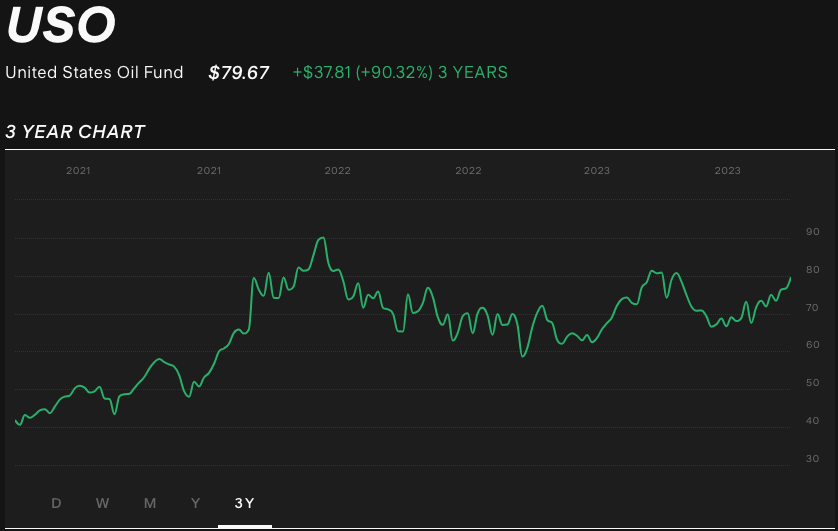
What are the best oil ETFs to watch in 2024?
As oil demand rebounds and oil prices inch higher, investor interest in oil is soaring. Get to know some of the oil ETFs traded on the U.S markets.
Is investing in oil still a good idea in 2024?
Investing in oil in 2024 presents both potential opportunities and challenges. On the positive side, oil prices have rebounded from historic lows, driven by recovering global demand as economies continue to reopen post-pandemic. Additionally, ongoing geopolitical tensions and supply constraints may support higher oil prices in the medium term.
However, the oil industry faces long-term headwinds, including the shift towards renewable energy and increasing environmental regulations. This has depressed the prices of many oil and gas companies around the globe, which has led to some value investors buying up shares. Legendary investor Warren Buffett is developing a substantial position in the oil markets, investing in Occidental Petroleum ($OXY).
Investing in oil, like any investment strategy, has its own set of advantages and disadvantages. It's essential to conduct thorough research, keep updated on market developments and be aware of the associated risks, and also consider individual circumstances, risk tolerance and goals. It's crucial to understand that past performance is not indicative of future results and that investing in any asset carries inherent risks.
Discover which are the best oil ETFs for your investment strategy
ETF Name | Ticker | Share Price | Year to Date | AUM | Expense Ratio |
|---|---|---|---|---|---|
United States Oil Fund LP | US$77.29 | 15.96% | US$1.36b | 0.60% | |
ProShares Ultra Bloomberg Crude Oil | US$32.20 | 23.37% | US$585m | 1.43% | |
Invesco DB Oil Fund | US$15.37 | 10.50% | US$249m | 0.77% | |
ProShares UltraShort Bloomberg Crude Oil | US$16.40 | -21.49% | US$199m | 0.95% | |
ProShares K-1 Free Crude Oil Strategy ETF | US$47.19 | 12.64% | US$139m | 0.73% | |
MicroSectors Oil & Gas Exp. & Prod. 3x Leveraged ETN | OILU | US$44.56 | 26.59% | US$68m | 0.95% |
United States 12 Month Oil Fund LP | US$39.36 | 12.11% | US$63m | 0.85% | |
MicroSectors Oil & Gas Exp. & Prod. -3x Inverse Leveraged ETN | US$14.94 | -27.09% | US$14m | 0.95% |
Data as of 28 March 2024 for share price, AUM and expense ratio. Source: Google Finance, ETFdb.
The list of funds mentioned is ranked by assets under management (AUM). When deciding what ETFs to feature, we analyse the financials, recent news, the state of the industry, and whether or not they are actively traded on Stake.

Delve deeper into the oil ETF list and learn more about these funds
1. United States Oil Fund LP ($USO)
Assets under management: US$1.36b
Share price (as of 28/03/2024): US$77.29
USO aims to track the daily price movements of West Texas Intermediate (WTI) crude oil futures contracts. It provides investors with exposure to the price of crude oil without directly investing in physical commodities. It is one of the most widely traded oil ETFs, offering liquidity and accessibility to investors seeking to gain exposure to oil prices.

2. ProShares Ultra Bloomberg Crude Oil ($UCO)
Assets under management: US$585m
Share price (as of 28/03/2024): US$32.20
UCO is a leveraged ETF that seeks to provide twice the daily performance of the Bloomberg WTI Crude Oil Subindex. This ETF is designed for investors who are bullish on oil prices and seek amplified returns based on short-term movements in crude oil prices.
However, it's important to note that leveraged ETFs like UCO carry higher levels of risk and volatility due to its leverage, and are therefore more suitable for experienced and risk-tolerant investors.
3. Invesco DB Oil Fund ($DBO)
Assets under management: US$249m
Share price (as of 28/03/2024): US$15.37
DBO is an ETF that tracks the performance of crude oil through futures contracts. Unlike some other oil ETFs, DBO holds futures contracts across multiple maturities to mitigate the impact of contango or backwardation in the futures curve.
This diversified approach aims to reduce the potential negative effects of roll yield on the fund's performance over time, trying to mimic the behaviour of physically holding the commodity without having to deal with any of the high costs associated with it.
4. ProShares UltraShort Bloomberg Crude Oil ($SCO)
Assets under management: US$199m
Share price (as of 28/03/2024): US$16.40
SCO is an inverse leveraged ETF that seeks to provide twice the inverse daily performance of the Bloomberg WTI Crude Oil Subindex. This ETF is designed for investors who are bearish on oil prices and seek amplified returns based on short-term declines in crude oil prices. Like other leveraged and inverse ETFs, SCO carries higher levels of risk and is more suitable for sophisticated investors.
5. ProShares K-1 Free Crude Oil Strategy ETF ($OILK)
Assets under management: US$139m
Share price (as of 28/03/2024): US$47.19
OILK is an ETF that tracks the performance of the S&P GSCI Crude Oil Excess Return Index. Unlike many other oil ETFs that invest in futures contracts, OILK utilises a unique strategy that seeks exposure to crude oil prices through a combination of equity securities and other financial instruments, providing investors with a different approach to gaining access to oil prices.
6. MicroSectors Oil & Gas Exp. & Prod. 3x Leveraged ETN ($OILU)
Assets under management: US$68m
Share price (as of 28/03/2024): US$44.56
OILU is an exchange-traded note (ETN) that seeks to provide three times the daily performance of the Solactive MicroSectors Oil & Gas Exploration & Production Index. This ETN has a leverage of 3x and is therefore designed for investors who are bullish on the oil and gas exploration and production sector and seek amplified returns based on short-term movements in the index.
The high leverage provided by the product makes it one of the riskiest alternatives in this list and therefore is more suitable for experienced investors.
$OILU is not available on Stake at this time.
7. United States 12 Month Oil Fund LP ($USL)
Assets under management: US$63m
Share price (as of 28/03/2024): US$39.36
USL is an ETF that invests in a diversified portfolio of 12 crude oil futures contracts with varying expiration dates. By holding futures contracts with different maturities, USL aims to minimise the impact of contango or backwardation in the futures curve, providing investors with exposure to oil prices over a longer time horizon.
8. MicroSectors Oil & Gas Exp. & Prod. -3x Inverse Leveraged ETN ($OILD)
Assets under management: US$14m
Share price (as of 28/03/2024): US$14.94
OILD is an exchange-traded note (ETN) that seeks to provide three times the inverse daily performance of the Solactive MicroSectors Oil & Gas Exploration & Production Index. This ETN has a leverage of 3x and is therefore designed for investors who are bearish on the oil and gas exploration and production sector and seek amplified returns based on short-term declines in the index.
Similar to other leveraged and inverse ETFs, OILD carries higher levels of risk and is more suitable for experienced investors.
How to invest in oil ETFs?
If you’re ready to start investing in oil ETFs you’ll need to open a brokerage account with an online broker or investment platform which involves the following steps:
1. Open a stock investing account
To invest in oil ETFs, you'll need to sign up to an investing platform with access to U.S. stock markets.
2. Fund your account
Complete an application with your personal and financial details. Fund your account with a bank transfer, debit card or even Apple/Google Pay.
3. Search for oil ETFs
Find the asset by searching for the name or ticker symbol. Do your own research to ensure it is the right investment product for your own circumstances.
4. Choose an order type and buy the asset
Buy on any trading day with a market, limit or stop order. Look into dollar cost averaging to spread out your risk, which smooths out buying at consistent intervals.
5. Monitor your investment
Optimise your portfolio by tracking how the security performs with an eye on the long term. You may be eligible for dividends and shareholder voting rights that affect your shares.
Get started with Stake
Sign up to Stake and join 750K investors accessing the ASX & Wall St all in one place.
What ways can you invest in oil?
These are the main ways you can invest in oil:
Stocks
Invest directly in individual oil companies listed in the U.S.
Exchange-traded Funds
Oil price-focused ETFs: These ETFs aim to track the performance of oil prices directly, usually by holding oil futures contracts or other oil-related derivatives.
Broad oil stock-focused ETFs: These ETFs hold a diversified portfolio of oil-related stocks, providing exposure to various companies involved in the oil industry, including exploration, production, refining and distribution.
Subsector-specific ETFs: These ETFs focus on specific segments of the oil industry, such as midstream companies (pipelines, storage), oilfield services, or integrated oil and gas companies.
Futures
Trading oil futures contracts involves entering into agreements to buy or sell a specific quantity of oil at a predetermined price at a future date. It's considered one of the riskiest ways to invest in oil due to the high level of leverage, price volatility and the potential for substantial losses if the market moves against the investor.
This method is typically more suitable for experienced traders who understand the complexities and risks associated with futures trading.
Other methods
Mutual funds: Some mutual funds specialise in investing in oil-related assets, providing investors with diversified exposure to the oil industry.
Direct investment: Investors can also consider direct investments in oil exploration and production projects, either through private placements or publicly traded partnerships.
What are the risks of investing in oil?
Investing in oil carries several significant risks that investors should carefully consider.
Oil prices are notoriously volatile, influenced by various factors such as geopolitical tensions, changes in supply and demand dynamics, economic conditions and unexpected events like natural disasters or geopolitical conflicts. These fluctuations can lead to rapid and substantial changes in the value of oil-related investments, impacting both short-term trading strategies and long-term investment positions.
The cyclical nature of the oil market means that periods of high prices can quickly be followed by downturns, amplifying risk for investors.
Political instability, conflicts in major oil-producing regions, trade disputes and sanctions can all impact oil production, transportation and pricing. Additionally, shifts in government policies, such as changes in taxation, regulation or energy transition initiatives, can directly affect the profitability of oil companies and their investment prospects. These geopolitical uncertainties add another layer of risk for investors in oil-related assets.
Environmental and regulatory risks also pose significant challenges for the oil industry. Increasing concerns about climate change and efforts to transition to cleaner energy sources could lead to long-term declines in global oil demand.
On top of that, regulatory measures aimed at reducing carbon emissions, promoting renewable energy adoption and enforcing environmental standards can increase operating costs for oil companies and restrict their ability to develop projects.
Environmental disasters, such as oil spills, also pose financial and reputational risks for oil companies and oil investors. As the world moves towards a lower-carbon future, these environmental and regulatory risks are likely to become more pronounced, affecting the attractiveness and risk/reward ratio of oil investments.
Oil ETFs FAQs
Investing in oil can offer opportunities for potential profits, particularly during periods of high demand or supply disruptions, but it also carries significant risks.
The oil market is highly volatile, influenced by geopolitical events, supply and demand dynamics, regulatory changes, and technological advancements.
Additionally, increasing concerns about climate change and the shift towards renewable energy sources pose long-term challenges to the oil industry.
Most oil ETFs do not pay dividends, but the Invesco DB Oil Fund and the ProShares K-1 Free Crude Oil Strategy ETF have paid dividends in the past.
As of the writing of this article, the largest oil ETF was the United States Oil Fund LP ($USO), with over US$1.36b in assets under management.
Investing in oil stocks carries both potential for high returns and significant risks.
Overall, the risks of investing in oil stocks should be similar to those of investing in oil itself, with the addendum of other business and company-specific risks.
Depending on these factors, investing in oil companies could be worse or better than investing directly in the commodity.
This does not constitute financial product advice nor a recommendation to invest in the securities listed. Past performance is not a reliable indicator of future performance. When you invest, your capital is at risk. You should consider your own investment objectives, financial situation, particular needs. The value of your investments can go down as well as up and you may receive back less than your original investment. As always, do your own research and consider seeking appropriate financial advice before investing.
Any advice provided by Stake is of general nature only and does not take into account your specific circumstances. Trading and volume data from the Stake investing platform for reference purposes only, the investment choices of others may not be appropriate for your needs and is not a reliable indicator of performance.

Rodrigo is a seasoned finance professional with a Finance MBA from Fundação Getúlio Vargas, one of Brazil's premier business schools. With seven years of experience in equities and derivatives, Rodrigo has a profound understanding of market dynamics and microstructure. Having worked for Brazil’s biggest retail algorithmic trading platform SmarttBot, his expertise focuses on risk management and the analysis, development and evaluation of trading systems for both U.S. and Brazilian stock exchanges.

